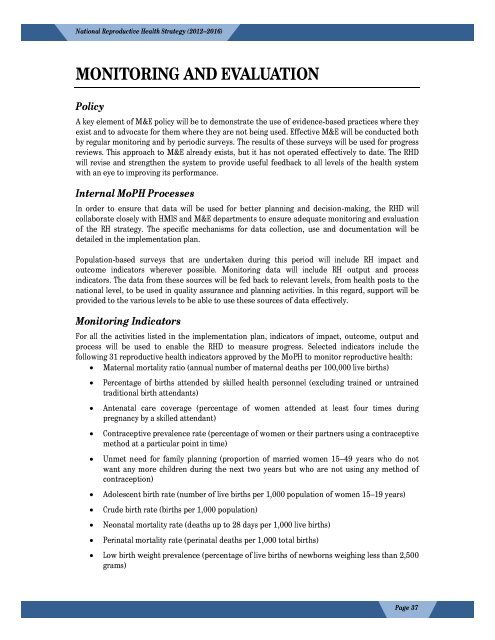national reproductive health strategy - Ministry of Public Health ...
national reproductive health strategy - Ministry of Public Health ...
national reproductive health strategy - Ministry of Public Health ...
You also want an ePaper? Increase the reach of your titles
YUMPU automatically turns print PDFs into web optimized ePapers that Google loves.
National Reproductive <strong>Health</strong> Strategy (2012–2016)MONITORING AND EVALUATIONPolicyA key element <strong>of</strong> M&E policy will be to demonstrate the use <strong>of</strong> evidence-based practices where theyexist and to advocate for them where they are not being used. Effective M&E will be conducted bothby regular monitoring and by periodic surveys. The results <strong>of</strong> these surveys will be used for progressreviews. This approach to M&E already exists, but it has not operated effectively to date. The RHDwill revise and strengthen the system to provide useful feedback to all levels <strong>of</strong> the <strong>health</strong> systemwith an eye to improving its performance.Internal MoPH ProcessesIn order to ensure that data will be used for better planning and decision-making, the RHD willcollaborate closely with HMIS and M&E departments to ensure adequate monitoring and evaluation<strong>of</strong> the RH <strong>strategy</strong>. The specific mechanisms for data collection, use and documentation will bedetailed in the implementation plan.Population-based surveys that are undertaken during this period will include RH impact andoutcome indicators wherever possible. Monitoring data will include RH output and processindicators. The data from these sources will be fed back to relevant levels, from <strong>health</strong> posts to the<strong>national</strong> level, to be used in quality assurance and planning activities. In this regard, support will beprovided to the various levels to be able to use these sources <strong>of</strong> data effectively.Monitoring IndicatorsFor all the activities listed in the implementation plan, indicators <strong>of</strong> impact, outcome, output andprocess will be used to enable the RHD to measure progress. Selected indicators include thefollowing 31 <strong>reproductive</strong> <strong>health</strong> indicators approved by the MoPH to monitor <strong>reproductive</strong> <strong>health</strong>: Maternal mortality ratio (annual number <strong>of</strong> maternal deaths per 100,000 live births)Percentage <strong>of</strong> births attended by skilled <strong>health</strong> personnel (excluding trained or untrainedtraditional birth attendants)Antenatal care coverage (percentage <strong>of</strong> women attended at least four times duringpregnancy by a skilled attendant)Contraceptive prevalence rate (percentage <strong>of</strong> women or their partners using a contraceptivemethod at a particular point in time)Unmet need for family planning (proportion <strong>of</strong> married women 15–49 years who do notwant any more children during the next two years but who are not using any method <strong>of</strong>contraception)Adolescent birth rate (number <strong>of</strong> live births per 1,000 population <strong>of</strong> women 15–19 years)Crude birth rate (births per 1,000 population)Neonatal mortality rate (deaths up to 28 days per 1,000 live births)Perinatal mortality rate (perinatal deaths per 1,000 total births) Low birth weight prevalence (percentage <strong>of</strong> live births <strong>of</strong> newborns weighing less than 2,500grams)Page 37














